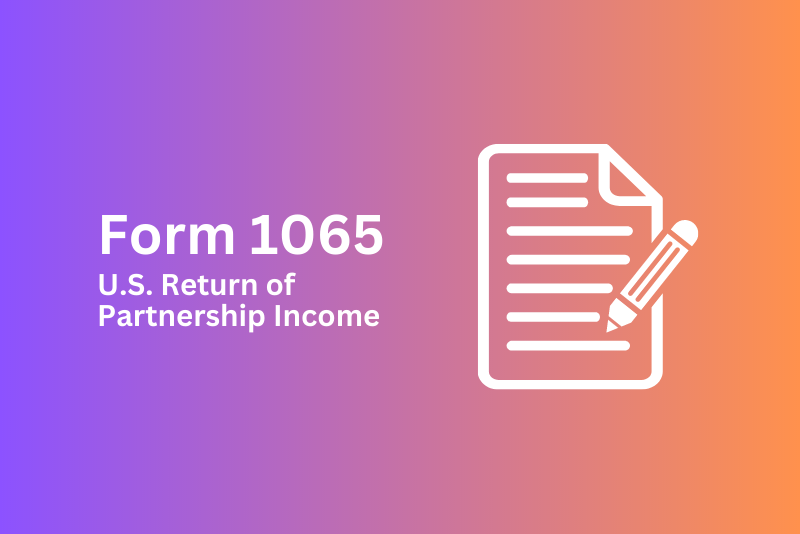Partnerships (and LLCs taxed as Partnerships) must get acquainted with this IRS Form 1065 for U.S. Return of Partnership Income. Form 1065 is an information return that Partnerships use to report their income, gains, losses, deductions, and credits.
While Partnerships are pass-through entities and business profits and losses flow through to the partners’ personal tax returns, Partnerships are still responsible for filing Form 1065 to report their financial information to the IRS. Moreover, a Partnership must use the form to prepare Schedule K-1 forms for its partners to identify the income and deductions that pass through to each owner so those individuals can report and pay their tax due.
Who Must File Form 1065?
- Domestic Partnerships such as General Partnerships, Limited Partnerships, and Limited Liability Partnerships.
- Multi-member Limited Liability Companies (LLCs), unless they’ve elected to be taxed as an S Corporation or C Corporation.
- Foreign Partnerships also must typically file a 1065 Form if they had gross income effectively connected with conducting business within the U.S. or gross income from sources in the United States during the tax year. If they meet those criteria, they must file the information return even if the business is located outside of the U.S. or the owners are foreign individuals. The IRS makes an exception for some Foreign Partnerships with U.S. source income and no effectively connected income during their tax year.
How to Fill Out Form 1065 for an LLC or Partnership?
The IRS provides instructions on its website. If you find them confusing or aren’t fully confident about completing the form correctly, it’s wise to ask a knowledgeable tax professional for assistance.
Some of the information requested on the Partnership tax return includes:
- Name and address of the Partnership
- Employer Identification Number (EIN)
- Date the business started
- Principal business activity
- Principal product or service
- Business code number
- Total assets
- Schedules K-1 (one for each partner associated with the company during the tax year)
- Income and expense information
- Deductions
- Tax payment info
What Is a Schedule K-1 (Form 1065)?
In a Partnership, the company’s profit or loss gets divided among the partners according to their distributive share (usually ownership percentage) as described in the company’s partnership agreement. A Schedule K-1 (Form 1065) must be prepared for each partner to identify the individual’s allocated profits and losses for the tax year. The Partnership must include the Schedule K-1 when filing their Partnership tax return and provide each partner with a copy of their Schedule K-1.
Each partner will then use their K-1 to report their share of the business profits and losses on Schedule E (Supplemental Income and Loss) of their personal tax return. Partners also use information from Schedule K-1 on Schedule SE (Form 1040) to figure out their tax due on net earnings from self-employment.
What Other Forms Must Be Filed With a 1065 Form?
It depends on the business, so I encourage partners to seek the assistance of a tax professional who can guide them through the process. The IRS details the order in which the various pages and parts should be assembled when submitting Form 1065.
This list will give you an idea of the other forms a Partnership may have to complete:
- Pages 1–5
- Schedule F (Form 1040), Profit or Loss From Farming (if required)
- Form 8825, Rental Real Estate Income and Expenses of a Partnership or an S Corporation (if required)
- Schedule D (Form 1065), Capital Gains and Losses (if required)
- Form 4797, Sales of Business Property (if required)
- Form 8949, Sales and Other Dispositions of Capital Assets (if required)
- Form 8996, Qualified Opportunity Fund (if required)
- Form 1125-A, Cost of Goods Sold (if required)
- Form 8941, Credit For Small Employer Health Insurance Premiums (if required)
- Form 6252, Installment Sale Income (if required)
- Form 8997, Initial and Annual Statement of Qualified Opportunity Fund (QOF) Investments (if required)
- Form 8938, Statement of Specified Foreign Financial Assets (if required)
- Any other schedules in alphabetical order, including Schedules K-2, K-3, and K-1 (Form 1065)
- Any other forms in numerical order
Who Can Sign a Partnership Tax Return?
The IRS allows any of the Partnership’s partners or any of the LLC’s members to sign the information return.
When Are Partnership Tax Returns Due?
Businesses must submit Form 1065 and Schedule K-1s by the 15th day of the third month after the partnership’s tax year ends. For example, if a partnership uses December 31 as its year-end, it must file its forms with the IRS by March 15th.
If the due date falls on a Saturday, Sunday, or legal holiday, the IRS will consider a return filed by the next day as on time.
Where to File Form 1065?
Partnerships may send Form 1065 by mail to the addresses provided on page 6 of the IRS’s instructions for Form 1065 (these are from the 2022 instructions, as the agency has not yet released instructions for 2023 at the time of this writing).
Electronic filing is also available via the IRS’s Modernized e-File (MeF) Platform. E-filing is optional for Partnerships with 100 or fewer partners. The IRS requires certain partnerships with more than 100 partners to file Form 1065, Schedules K-1, and other tax-related forms electronically.
Can You File an Extension for Form 1065?
Yes. If a business is up against the filing deadline, it may request a six-month extension by submitting Form 7004, Application for Automatic Extension of Time To File Certain Business Income Tax, Information, and Other Returns. Note that the extension gives the Partnership more time to file its information return, but partners must still pay their share of any anticipated taxes due by the original deadline.
Are There Penalties for Not Filing On Time?
If a Partnership fails to file its Form 1065 by the due date or files an incomplete return, it could face a penalty of $220 (multiplied by the number of partners) for each month (up to 12 months) that the failure continues.
The IRS also issues penalties for failing to furnish complete Schedules K-1 to its partners by the due date. The Partnership could face a fee of $290 for each Schedule K-1 it didn’t provide or didn’t have all the required information for — with a maximum penalty of $3,532,500.
The price tag gets even steeper if a Partnership intentionally disregards the requirement to report correct information. The penalty in that situation jumps to $580 per K-1 or 10 percent of the aggregate amount of items to be reported — whichever is greater, with no maximum penalty limit!
Get Help If You Need It
For any tax-related matters, it’s better to be safe than sorry! Filing a 1065 form and figuring out which other associated forms are required can be overwhelming and confusing. Business owners can reach out to the IRS with questions at 800-829-4933 or request a face-to-face meeting at a local IRS office. Also, consider working with a tax professional who specializes in preparing and filing business tax returns.





